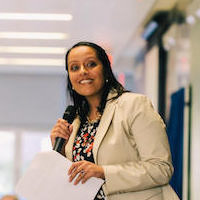Interview with Sheila Vakharia – Assistant Professor at Long Island University | Substance Abuse & Ethics

About Sheila Vakharia, Ph.D., MSW: Sheila Vakharia earned her doctorate at Florida International University’s School of Social Work. She received her Master’s in Social Work from Binghamton University and a Post-Master’s Certificate in the Addictions from New York University. She was most recently employed as a social worker at a grassroots HIV/AIDS and homelessness advocacy organization in Manhattan, where she provided harm reduction-based substance use counseling, facilitated harm reduction support groups, and conducted quality assurance activities. She was also a SIFI certified field instructor for B.S.W. students from New York University at that time. Prior to that, she worked at an OASAS-licensed rural outpatient substance use treatment facility where she conducted diagnostic assessments, made level-of-care treatment determinations, and facilitated aftercare groups for individuals with co-occurring disorders. Sheila Vakharia was compensated to participate in this interview.
[OnlineMSWPrograms.com] Why is accreditation by the Council on Social Work Education so important?
[Sheila Vakharia, Ph.D., MSW] CSWE accreditation is essential for any student who is interested is pursuing a bachelor’s or master’s degree in social work. Accreditation ensures that you are in a program that meets the basic minimum requirements to give you a solid social work background. It means that your curriculum includes specific foundational social work courses on theory and policy, that you have interned under licensed social workers for a certain number of hours during your training, and that you are being held to the social work code of ethics.
[OnlineMSWPrograms.com] You specialize in “ethical issues in the treatment of substance abuse,” amongst other subjects. What are the paramount ethical issues in the treatment of substance abuse?
[Sheila Vakharia, Ph.D., MSW] At least one third of all people who attend substance use treatment in the United States are mandated. They are mandated by their workplace, social service providers, or the criminal justice system. This means that they are in treatment because someone else has determined that they must either attend treatment or potentially lose their job, benefits, or even get into more trouble with the law. I believe that this puts treatment providers in a bind because although they are ethically bound to provide the best care to their clients and engage them to work toward change, providers must also be mindful that the mandating bodies that have sent people to treatment may make the client face some harsh consequences if they do not succeed in treatment. It may make providers feel like they are caught between what their clients want and what the mandating body expects.
[OnlineMSWPrograms.com] How do you prepare your students to address those issues?
[Sheila Vakharia, Ph.D., MSW] I openly discuss these issues with my students and encourage them to bring in their own experiences from their internship placements into the classroom. We talk about the conflicts between what the NASW Code of Ethics may promote and what we may be expected to do in the real world environment where agencies are motivated to “keep their numbers up” and maintain working relationships with referring/mandating agencies which may have their own vested interests.
[OnlineMSWPrograms.com] One of your recent publications is titled “Starting where the client is: Harm reduction guidelines for clinical social work practice.” Can you tell us a little but about this paper?
[Sheila Vakharia, Ph.D., MSW] This paper is intended to be an important contribution to the discourse on social work practice in the addictions. At present, the field of substance use treatment is fixated upon an abstinence-only framework and, although some seminal NASW documents have been released that say a harm reduction approach may be beneficial, little has been written on how this would look in practice from a social worker’s perspective. This paper attempts to break down how a harm reduction approach can be implemented in social work with clear examples and case studies, as well as an introduction to how needs can be assessed and how treatment plans can be written. I really hope that this paper can open the eyes to practitioners on how they can use this alternative approach to help their clients.
[OnlineMSWPrograms.com] Prior to becoming a professor at LIU Brooklyn, you were a social worker at a grassroots HIV and AIDS and homelessness advocacy organization in Manhattan. What is the connection between HIV and AIDS and homelessness that necessitates an organization to address both?
[Sheila Vakharia, Ph.D., MSW] The founders of the organization I worked for saw firsthand that a significant number of people who are homeless or unstably housed are at high risk for a number of other co-occurring health and mental health problems which are exacerbated by lack of stability in their lives. Until someone has a roof over their head, they’re not necessarily going to be in the best position to have the time, energy, and resources to focus on their health. The organization really believed in the housing-first model, which states that housing homeless people is the best way to improve their lives and well-being. Rather than expecting people to meet certain standards of behavior before being placed in housing, the simple act of providing someone with a place to live can set their lives on course towards better self-care, reduced risk behaviors, and increased compliance with medical treatment.
Thank you Sheila Vakharia for your time and insight into social work!
Last updated: April 2020

